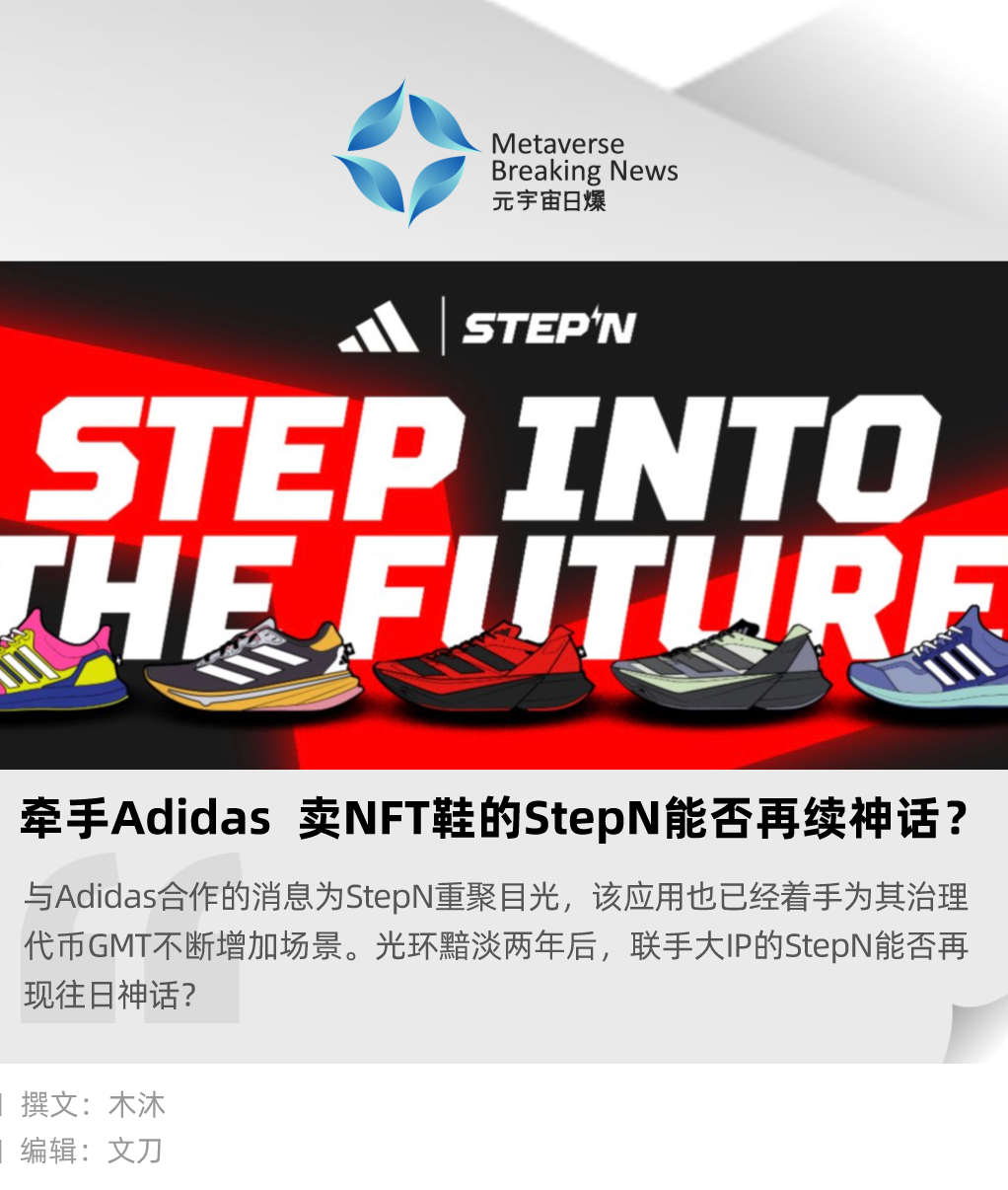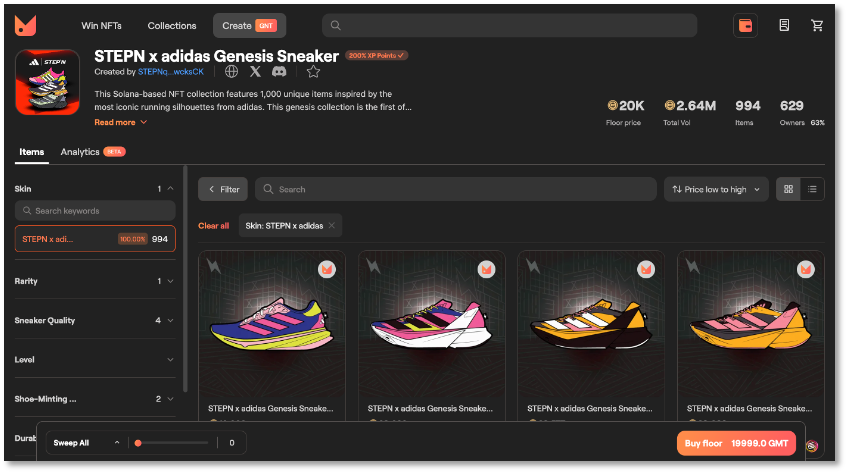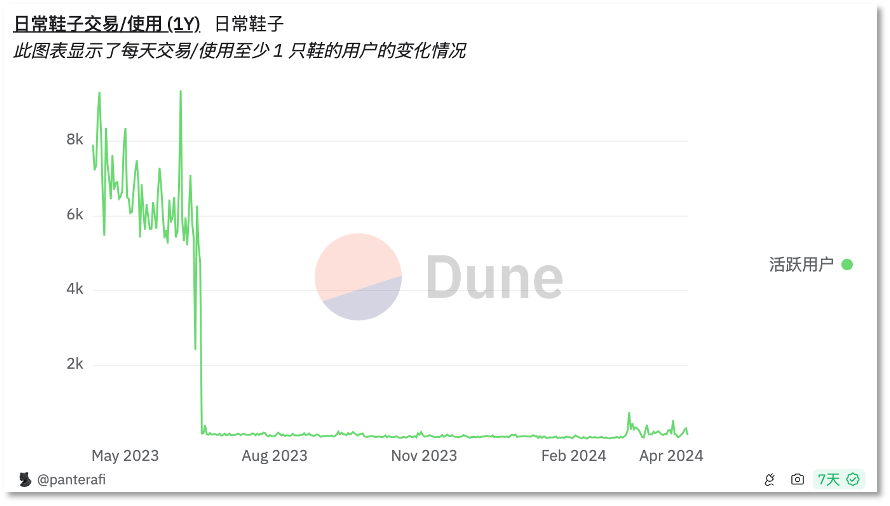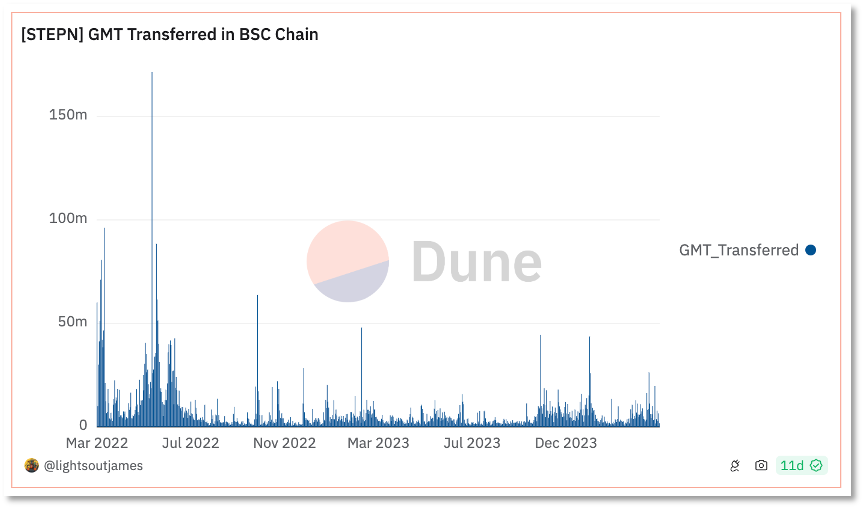
It's hard for old players in the Web3 world not to know about StepN. Recently, this Web3 application that once pushed the "Move To Earn" gameplay to the world has finally made a new move after two years of silence: On April 15th, StepN announced a collaboration with the well-known sports brand Adidas to launch a gameplay combining physical items and NFT, returning to the NFT user's field of vision.
In 2022, StepN, which aimed to "let 3 million people own their first pair of virtual shoes," was popular worldwide. Track and field enthusiasts in Japan, Singapore, the United States, the United Kingdom, and even in many parts of China received a pair of "NFT sneakers" from StepN in a "earn while you walk" manner. From then on, the mileage of walking or running was no longer just a "show-off" in the friend circle, but could also be monetized through NFT.
By transforming the popular "Play To Earn" mode in GameFi, StepN's "Move to Earn" gameplay quickly gained popularity, especially driving those Web2 users who are willing to share their "daily steps" on WeChat moments or sports apps.
Unfortunately, the good times didn't last long. In May 2022, StepN suddenly announced the expulsion of mainland Chinese users, causing a significant drop in related encrypted assets within the application ecosystem. The "death spiral" that GameFi projects had experienced long ago came to haunt StepN, and since then, the downhill path became an inevitable part of the application's journey.
The news of the collaboration with Adidas has brought attention back to StepN, and the application has begun to empower its governance token GMT once again. The development team, Find Satoshi Lab, launched a blockchain game called Gas Hero last year, and GMT has added another application scenario as a game token. Two years after the dimming of its halo, can StepN, in collaboration with the major IP Adidas, recreate its past glory?
StepN Joins Hands with Adidas to Shine Again

The NFT sneakers launched by StepN in collaboration with Adidas are named "STEPNxAdidas Genesis Sneakers." Public information shows that this NFT sneaker series is built on the Solana blockchain and includes 1000 unique items, inspired by the most iconic running shoe silhouette of Adidas.
 The NFT sneakers launched by StepN and Adidas have been successfully minted
The NFT sneakers launched by StepN and Adidas have been successfully minted
As of now, the STEPNxAdidas Genesis Sneakers series of 1000 NFT sneakers has been successfully minted on the MOOAR market, with a successful minting quantity of 994 and 629 holder addresses. The token used to consume this NFT series is StepN's governance token GMT. Currently, the floor price of this NFT series is 20,000 GMT, while the secondary market price of GMT is temporarily at $0.24. Therefore, the floor price of STEPNxAdidas Genesis Sneakers NFT is equivalent to $4,800.
It's worth noting that on April 17th, when this NFT was distributed on MOOAR through a lottery, the unit price was still 10,000 GMT, which was approximately $2,500 at the time. As of April 25th, priced in GMT, the floor price of this NFT has doubled, and priced in USDT (US dollar stablecoin), the floor price has increased by 92%.
Users who directly benefit from the increase in floor price of this NFT are mainly from the community members led by Adidas and StepN's development team, Find Satoshi Lab (FSL), who were whitelisted for the lottery distribution. It is reported that they will also receive exclusive benefits. Prior to this, StepN also launched a $30 million airdrop activity for loyal players and ecosystem asset holders.
From the above dynamics, the release of the STEPNxAdidas Genesis Sneakers series seems more like a sticky activity for old users.

Dune data also shows that StepN's user activity has increased slightly before and after this release activity, but compared to the data before August 2023, this rebound in activity is just a "small wave."

"Death Spiral" Remains Unrepaired

StepN's heyday came to an end in May 2022 when the project officially announced the cessation of GPS and IP location services for mainland Chinese users in response to corresponding regulatory policies, effectively ending its operations in the Chinese mainland market. This was followed by a sharp drop in the project's ecosystem tokens GMT and GST, as well as a halving of the price of NFT sneakers. The "death spiral" that GameFi projects find hard to escape also began to approach StepN.
 StepN's GMT experienced a brief peak in 2022 before falling silent
StepN's GMT experienced a brief peak in 2022 before falling silent
Similar to another phenomenal blockchain game, Axie, the "dual token" economic model failed again with StepN. In its economic system, the unlimited supply of GST is the reward generated by users' physical activities, mainly used to enhance the gaming experience, such as creating, repairing, and upgrading NFT sneakers. On the other hand, the total supply of GMT, approximately 5.368 billion, is defined as the governance token, mainly used for trading NFT or as collateral in financial scenarios within the game.
StepN needs to find a way to maintain a relatively balanced state between token production and consumption. However, with unlimited supply but limited scenarios, GST is likely to experience a situation where production exceeds consumption. On the other hand, GMT not only has limited scenarios but is also strongly tied to the value of NFT. If GMT or NFT rapidly depreciate, it could lead to a significant drop in the value of both assets, thus forming a vicious cycle.
The "sudden expulsion" announcement in May 2022 became a catalyst, quickly exposing the flaws in StepN's dual token model.
As of now, StepN still maintains the dual token model and is trying to increase the application scenarios for the tokens, especially for GMT, which better represents the project's market value.
First is the "united strategy." Currently, GMT is the voting token for the NFT market MOOAR's members, and these members can use GMT to vote for the pre-issued NFT on the "Launchpad" section of MOOAR. Users who win the vote have the opportunity to obtain the minting rights for the new NFT. This practice has increased the application scenarios for GMT.
In addition, MOOAR members can also trade NFT with GMT or create AIGC NFT collections. This practice aims to increase the consumption of GMT.
In addition to external collaborations, StepN is also creating new use cases for GMT within its ecosystem. At the end of last year, the development team, Find Satoshi Lab, launched the blockchain game "Gas Hero," which did not issue new tokens but directly used GMT as the in-game consumption token, such as for enhancing game characters. The development team also allocated approximately 2 million GMT to reward the creators of game characters and promised to pay a 2% royalty.
With efforts to increase scenarios and consumption, GMT gradually rose from its lowest point of $0.1 to $0.24 under the empowerment of StepN. According to CoinGecko, the token's year-to-date increase is -26.5%, and on April 28, 2022, GMT reached a peak of $4.11.
However, it seems that the empowerment of scenarios has not brought about fundamental changes. Of note is that after the collaboration between StepN and Adidas on NFT, the two parties will also jointly launch physical goods. There have been successful cases of NFT IP transitioning to physical goods, such as the NFT series "Pudgy Penguins," which launched Pudgy Toys and was well-received by ordinary consumers, even driving sales of native NFTs at one point.
As a former phenomenal product, StepN once accumulated a user base in the previous cycle, which is its advantage. After collaborating with a major IP like Adidas, the more important direction is not just to attract old users by issuing new shoe NFTs, but to leverage the strength of the collaboration and re-emerge, transforming itself into a more widely and innovatively applied IP. After all, only traffic can bring the volume of funds that may drive the value of encrypted assets within the ecosystem.
免责声明:本文章仅代表作者个人观点,不代表本平台的立场和观点。本文章仅供信息分享,不构成对任何人的任何投资建议。用户与作者之间的任何争议,与本平台无关。如网页中刊载的文章或图片涉及侵权,请提供相关的权利证明和身份证明发送邮件到support@aicoin.com,本平台相关工作人员将会进行核查。




